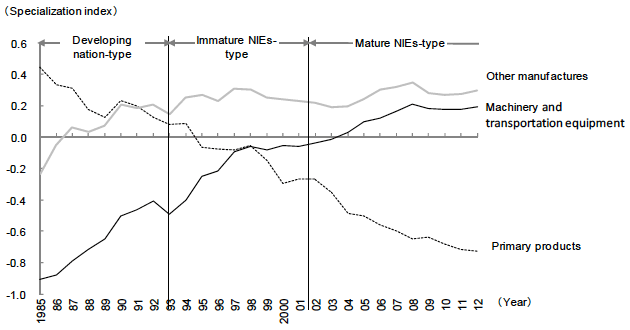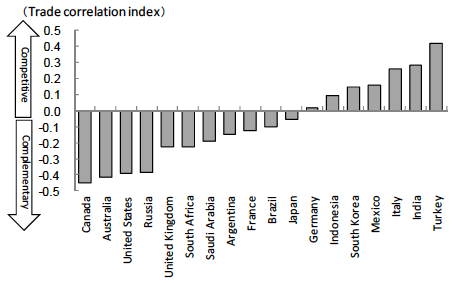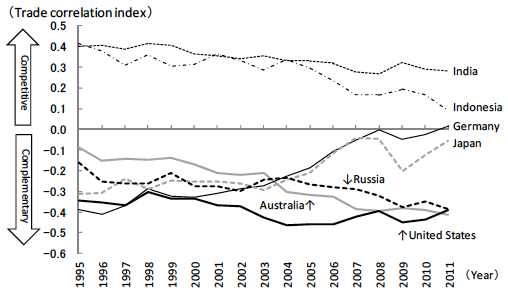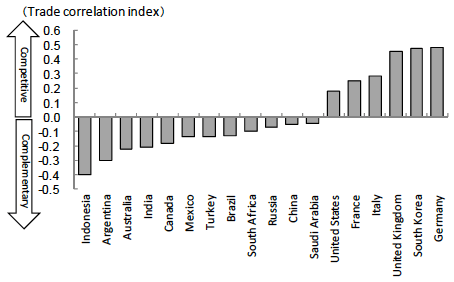The trade structure of China has become more sophisticated in recent years, moving from one that characterizes newly industrializing economies (NIEs) toward one that is typical of industrialized nations. As a result, China's complementarity with some industrialized nations has been diminishing while competition with NIEs has been decreasing. The trade structure between Japan and China is also changing from complementarity to competition.
In China, exports have struggled recently in certain labor-intensive industries against a backdrop of increasing wages associated with labor shortages and a rise in the real exchange rate. An overseas transfer of production has begun, and many people believe that the hollowing out of industry is progressing in China as Japan had experienced before it. However, this view misses the forest for the trees. In fact, low value-added industries are exiting the scene, while higher value-added sectors are growing in China, showing that industry is becoming steadily more sophisticated as indicated by changes in the trade structure described below.
Many countries, including Japan, have followed a pattern in step with their economic development in which their exports core shifts from the primary to secondary industry, and then within the secondary industry, from labor-intensive to capital- and technology-intensive products. This can be confirmed by tracking changes in the specialization index (the value obtained by dividing the difference between exports and imports by the sum of exports and imports, in which the larger the value, the stronger is the international competitiveness) for major items (Figure 1). More specifically, depending on the relative scale of the specialization index for primary products (the Standard International Trade Classification (SITC) sections 0-4), other manufactures (SITC sections 5, 6, 8, and 9, manufactures other than machinery and transportation equipment), and machinery and transportation equipment (SITC section 7), the trade structure of a country can be classified into four stages: developing nation-type, immature NIEs-type, mature NIEs-type, and industrialized nation-type. Based on this classification, the trade structure of China is moving from the mature NIEs-type toward the industrialized nation-type.
China's complementary and competitive relationships with other countries have also been changing significantly, reflecting progress in the sophistication of the trade structure. This can be confirmed by changes in the trade correlation index compiled by the United Nations Conference on Trade and Development (UNCTAD), which shows the similarity between the trade structures of two countries. The trade correlation index ranges from +1 to -1 and indicates that the larger the value (closer to +1), the more similar and competitive (the less complementary) are the trade structures of the two countries. Vice versa, the smaller the value (closer to -1), the more different and less competitive (the more complementary) are the trade structures of the two countries.
According to the trade correlation index, China has a tendency of competing less with (being more complementary to) industrialized nations and resources countries, and relatively more with (being less complementary to) NIEs (Figure 2). However, notable changes have been taking place recently, as shown below (Figure 3).




The trade correlation index and, in turn, China's competition with NIEs such as India and Indonesia have been declining. This reflects the fact that industrial upgrading has been advancing more quickly in China, which has become more specialized in the export of higher value-added products than these countries. The transfer of production from China to other NIEs is expected to accelerate in the future, particularly in labor-intensive industries.
The negative value of the trade correlation index of China with resource-rich countries such as Australia and Russia has been expanding. This shows that, with the international competitiveness of its primary products declining, China's complementarity with these countries is increasing.
In addition, the trade correlation index of China with industrialized nations such as Japan and Germany has been rising. Behind this change is a rise in China's competition with these countries as a result of the shift in its comparative advantage from labor-intensive products to higher value-added products such as machinery and transportation equipment.
More specifically, the trade correlation index of China with Japan has been trending upward, from -0.31 in 1995 to -0.05 in 2011. This appears to reflect not only the growing sophistication of the industrial structure in China but also the slow pace of industrial upgrading in Japan. Nevertheless, although Japan's competition with China has been increasing, it is still low compared to that with other industrialized nations such as Germany, South Korea, the United Kingdom, Italy, France, and the United States (Figure 4).
Many people believe that a sharp rise in the export of industrial products from China has been the major cause of the hollowing out of industry and, in turn, the long-term economic stagnation in Japan. However, given that China's strength has been concentrated in labor-intensive products that compete little with Japan, this view misses the point. The real challenge for Japan is to cope with further industrial upgrading in China, which is likely to take the form of rising competitiveness in its machinery and transportation equipment sector, an area where Japan has taken the lead so far.



